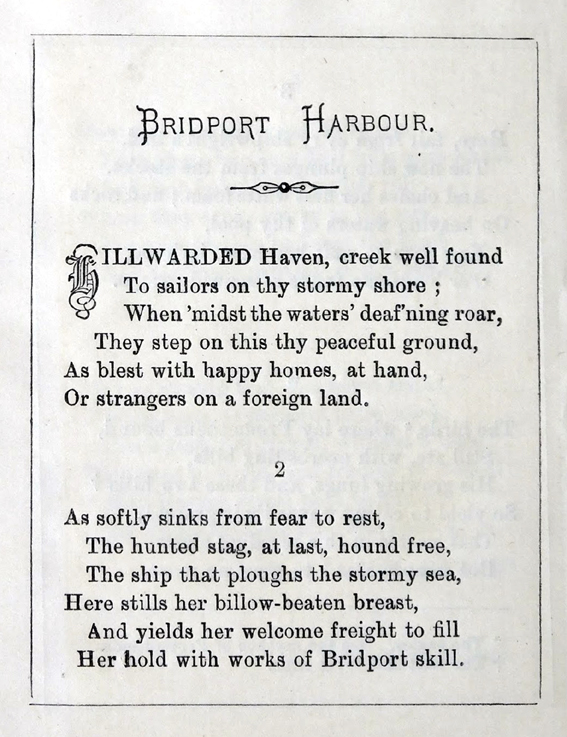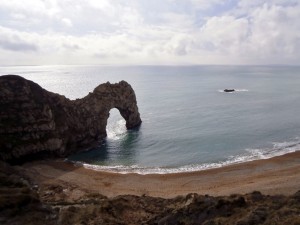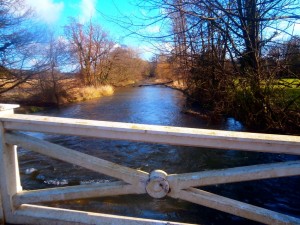Barnes, Hardy and the Sea
Jim Potts
I've been thinking for some time how little Barnes wrote about the sea or the Dorset coast. Thomas Hardy wrote much more. Barnes was always more fascinated and inspired by 'the sounds of flowing water', by rivers, brooks and streams, as well as by mills and water lilies - and of course by the countryside around the Blackmore Vale. He writes affectionately of the Stour and the Frome, the Lydden and Caundle Brook.
I was surprised to read, in an article by Charlotte Lindgren, Llewelyn Powys at White Nothe (The Dorset Year Book, 1992, p 57-63) that Llewelyn and his brother Littlejohn had considered collaborating on a book about William Barnes. Llewelyn, "with his own love of the sea...found it curious that Barnes had never written about the sea" (page 63). In his short essay on Barnes in Thirteen Worthies (New York, 1923), Powys writes: "Bagbere (sic), the little hamlet where William Barnes was born, is situated on the banks of the River Stour, and his poetry is almost entirely concerned with the fields, homesteads, straw-strewn bartons and grassy honeysuckle lanes that are within walking distance of that most lovely river. Indeed there are many people who find it difficult to dissociate his poetry from its slowly moving waters....Of all English rivers, the River Stour is the most friendly".

It is not quite true that Barnes never wrote about the sea, but we might have expected to discover much more from his pen, as he did give lectures in places like Weymouth and Bridport. Perhaps he was unable to make visits to the seaside when growing up in the Blackmore Vale, before the arrival of the railway. From Dorchester or from his Came Rectory it would have been easier to reach the coast. Did he feel it inappropriate to be seen strolling down seaside esplanades once he had embarked on his career as a schoolmaster and later as a vicar, dressed in his old-fashioned clothing? Or was the seaside simply never the landscape of his imagination or a preferred destination of his walks? His childhood landscapes around the Blackmore Vale continued to preoccupy and dominate the topics of his poetic expression.
Let's think first of some of his many poems that feature rivers and streams:
The Aquatic Excursion
The Brook that ran by Gramfer's
Grenley Water
The Bwoat
Pentridge by the River
Leeburn Mill
The Flood in Spring
Zummer Stream
Vields by Watervalls
Our Early Landscape
The River Stour
The River-Sundered Houses
The Infalling Stream
By the Mill in Spring
The Stream-Zide
Water Gliding Down
The Reeds about the Pool
Fall Tide
The Wind Up the Stream
Rivers Don't Gi'e Out
The Clote
The Water Crowvoot
Sound O'Water
The Bonnet in the Water
There are probably more. His poems that feature the sea include:
Bridport Harbour
Orra: A Lapland Tale
Eclogue: Rusticus Emigrans, Emigration
Over Sea to Settle
The Sailor
I'm Out O' Door
Cwold Harbour
Thomas Hardy, although he also composed poems about rivers like the Stour (Overlooking the River Stour), wrote a substantial number of poems referring to the sea:
Faintheart in a Railway Train
I Found Her Out There
The Harbour Bridge
Beeny Cliff
A Dream or No
Once at Swanage
If You Had Known
At Lulworth Cove a Century Back
At a Seaside Town in 1869
Embarcation, Southampton Docks: October 1899
To a Sea Cliff
The Sea Fight
Genoa and the Mediterranean
The Convergence of the Twain
On the Esplanade, Midsummer:10pm
At the Aquatic Sports
Hardy was particularly inspired by the Cornish cliffs, coastline and wild seas around Boscastle and St. Juliot (see also his novel, A Pair of Blue Eyes).
"O the opal and the sapphire of that wandering western sea!"(Beeny Cliff, March 1870-March 1913)
The Dorset coast captured his imagination too, like Port Bredy (Bridport) harbour, in the Wessex tale, Fellow-Townsmen:
"The wind had already shifted violently, and now smelt of the sea. The harbour-road soon began to justify its name. A gap appeared in the rampart of hills which shut out the sea, and on the left of the opening rose a vertical cliff, coloured a burning orange by the sunlight, the companion cliff on the right being livid in shade. Between these cliffs, like the Libyan bay which sheltered the shipwrecked Trojans, was a little haven, seemingly a beginning made by Nature herself of a perfect harbour, which appealed to the passer-by as only requiring a little human industry to finish it and make it famous, the ground on each side as far back as the daisied slopes that bounded the interior valley being a mere layer of blown sand. But the Port-Bredy burgesses a mile inland had, in the course of ten centuries, responded many times to that mute appeal, with the result that the tides had invariably choked up their works with sand and shingle as soon as completed. There were but few houses here: a rough pier, a few boats, some stores, an inn, a residence or two, a ketch unloading in the harbour, were the chief features of the settlement".
William Barnes 'seldom faced the seaward view', although his poem on Bridport Harbour stands well alongside that paragraph of Hardy's.
Hardy wrote poems about Weymouth, Lulworth Cove, Swanage, Durlston Head, Plymouth and Southampton.
The Mediterranean also captured his imagination, in the poem Genoa and the Mediterranean, March 1887:
"O epic-famed, god-haunted Central Sea".
I sometimes wish that Barnes had travelled to Italy and given us his poetic impressions of the seascapes he might have enjoyed there. As Llewelyn Powys observed, it is curious that he didn't feel inspired to portray or evoke more Dorsetshire seascapes.








